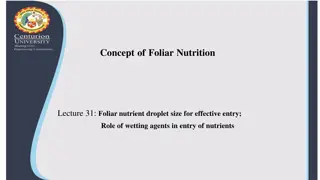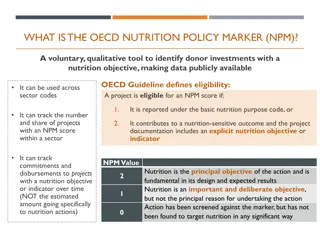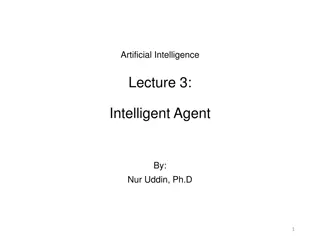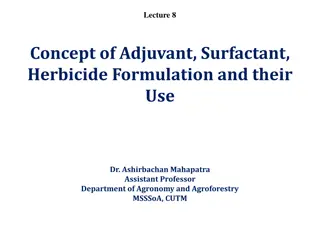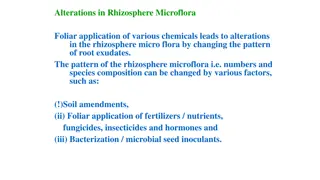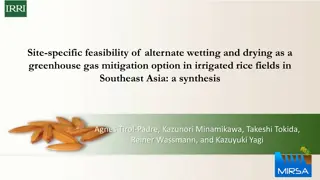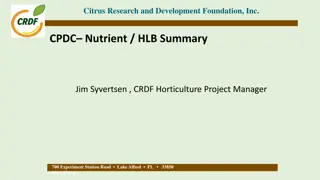Understanding Foliar Nutrition: Droplet Size and Wetting Agents
Foliar nutrition focuses on the effective entry of nutrients into plants through foliar applications. Key factors include droplet size for optimal absorption, the role of wetting agents in nutrient entry, and the importance of fertilizer materials with high solubility and purity. Smaller droplets enhance coverage, while wetting agents aid in water uptake and substrate re-wetting. Selecting suitable nitrogen and phosphorus materials is crucial for successful foliar fertilization.
Download Presentation

Please find below an Image/Link to download the presentation.
The content on the website is provided AS IS for your information and personal use only. It may not be sold, licensed, or shared on other websites without obtaining consent from the author. Download presentation by click this link. If you encounter any issues during the download, it is possible that the publisher has removed the file from their server.
E N D
Presentation Transcript
Concept of Foliar Nutrition Lecture 31: Foliar nutrient droplet size for effective entry; Role of wetting agents in entry of nutrients
Mechanism of foliar fertilization: Nutrients must enter the leaf before entering into the cytoplasm of the leaf cell. Nutrients must effectively penetrate the outer cuticle and wall of the epidermal cell. Once penetration has occurred, nutrient absorption by the cell is similar to absorption by the roots. Among all the components the cuticle offers the greatest resistance to the nutrients.
Foliar nutrient droplet size for effective entry Smaller droplets cover a larger area and increase efficiency of foliar applications. However, when droplets are too small (less than 100 microns), a drift might occur.
Role of wetting agents in entry of nutrients A wetting agent facilitates the uptake of water during initial wetting and optimizes the movement of water in the substrate which improves the re-wetting of over-dry plants. This is due to the wetting agent s ability in lowering the surface tension of water which allows it to spread more easily and evenly in the peat. The wetting agent does not affect the total water uptake of the substrate so the plants, or more precisely the pots, do not take up any extra water because of the wetting agent added to the substrate.
There are two reasons for adding wetting agent: Initial water uptake When taking the packed peat at packing moisture into use, growers are adding water in order to maximize the expansion of the substrate. This is to gain maximum air capacity providing good and well aeriated growing conditions for plants. The water addition causes the expansion and opening of the substrate and also increases the outturn volume of the packages. Water uptake of plants The wetting agent supports re-wettability of dried substrates during growing. The widely used practice of letting the substrate dry in order to compact the plants is basically only possible when there is a contained wetting agent which secures the re-wetting of the substrate. Plants in the corners of the greenhouse or tables are re-wetting better also due to the wetting agent.
Fertilizer Materials Not all fertilizers are suitable for use as a foliar spray. Qualifications for fertilizer materials should have high solubility, low salt index and high purity. Types of fertilizer material Nitrogen Materials: Urea is the most suitable nitrogen source for foliar applications, due to its low salt index and high solubility in comparison to other nitrogen sources. IFFCO nano urea is becoming popular as a nitrogen source. Phosphorus Materials: A combination of poly and ortho-phosphates shown to lessen leaf burn and aid in leaf phosphate absorption. The polyphosphate advantage may also be due to supplying both ortho and polyphosphate forms
Potassium Materials: Depending on availability, potassium polyphosphates are an excellent source of low salt index, highly soluble potassium. Potassium sulfate has low salt index, but a rather low solubility. Secondary and Micronutrient Materials: Foliar application of secondary nutrients can be highly effective, but because of difficulties associated with leaf tissue absorption and translocation choosing the correct fertilizer sources for these nutrients becomes very critical.




